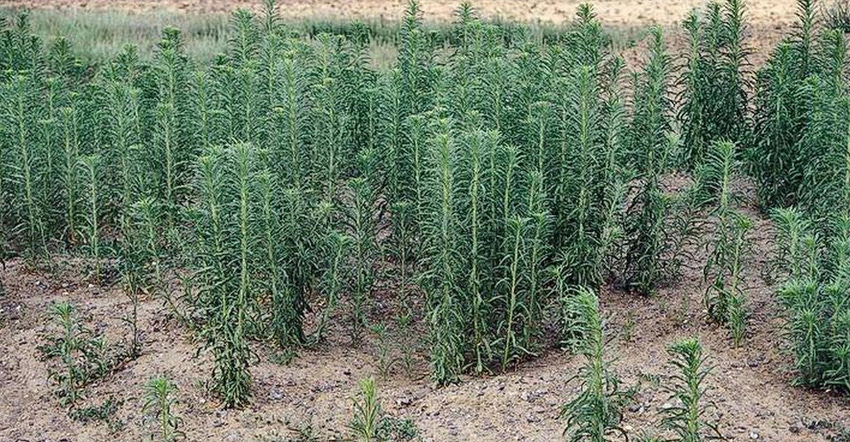March 7, 2017

There are five steps to controlling horseweed:
1. Apply effective herbicides in the fall.
2. Apply residual herbicides in the spring.
3. Apply herbicides to rosette horseweed plants. Bolted plants are much more difficult to control.
4. Apply herbicides in at least 10 to 15 gallons of water per acre.
5. Apply Sharpen or Sharpen + Spartan with MSO + AMS 131.
Horseweed, also known as marestail, is a winter or summer annual weed that is native to North America. In North Dakota, where it was named the 2017 Weed of the Year, horseweed is most troublesome when it emerges in the fall, overwinters as a rosette and then elongates (bolts) in early spring.
In contrast, in some Midwest states spring-emerging horseweed has been more troublesome because of late emergence in May and June. Horseweed’s wide emergence window often allows it to escape preplant and preemergence (PRE) herbicides. In addition, many postemergent (POST) herbicides do not provide effective horseweed control.
Horseweed typically grows 3 to 6 feet tall and can produce up to 200,000 seeds per plant. Similar to dandelion, horseweed seed is attached to a white pappus that is easily dispersed several hundred yards by wind. It has been reported that up to 91% of the fall-emerging plants survive until spring. Overwintering rosettes will start to bolt fairly early in the spring.
Horseweed is much easier to control in the rosette stage than the bolting stage.
History
Horseweed tends to thrive in no-till systems but is more easily controlled using conventional tillage. Plants that emerge in the fall are typically killed easily with spring tillage. An Indiana survey showed horseweed was found in 61% of no-till fields, in 24% of reduced-till fields, and in 8% of conventional-till fields. It has been shown that tilling the top 0.25 inch of soil provides about 95% horseweed control.
Horseweed’s ability to emerge in the fall and throughout the growing season allows it to be very competitive with crops. An Ohio State University study showed the effect of horseweed on soybean yields:
• 51 bushels per acre where the burndown treatment failed to control emerged plants
• 57 bushels per acre where the burndown treatment was effective, but there was no residual herbicide
• 65 bushels per acre where the burndown was effective and residual herbicides were used
Resistance
Horseweed biotypes are tolerant or resistant to many herbicide groups including 2, 3, 6, 8, 9, 14, 15 and 27. Glyphosate-resistant horseweed has been found in several locations in North Dakota. While 2,4-D has been a common product used to control horseweed in many states, some states now indicate that 2,4-D is not as effective as it once was. It is important to use multiple modes of action to control horseweed and not rely on one herbicide year after year. It is critical to not rely on glyphosate alone to control horseweed.
Control
Efforts to control horseweed should always begin in the fall. Consider rotation restrictions when selecting fall or spring herbicides.
Fall applications
Glyphosate + 2,4-D with or without Sharpen
Glyphosate + Sharpen
Glyphosate + dicamba (follow crop rotation restrictions)
Glyphosate + Valor + 2,4-D (consider applying Valor separate from glyphosate + 2,4-D to avoid antagonism from rapid burn on foliage)
Wheat
Preplant or PRE: Glyphosate + 2,4-D with or without Sharpen
POST: 2,4-D + Starane Flex with or without SU, Huskie/Huskie Complete, GoldSky, Kochiavore, PerfectMatch, WideMatch and Weld
Dry pea
Preplant or PRE: Glyphosate + Sharpen without Spartan or Glyphosate + Metribuzin
POST: Basagran (2 pints per acre required for 80% control) + methylated vegetable or seed oils (MSO) adjuvant
Soybean
Fall: Glyphosate + 2,4-D with or without Sharpen
Preplant or PRE:
• Glyphosate + 2,4-D ester (seven-day plant-back for ester)
• Glyphosate + Sharpen (plant-back interval: 0 day, 1 ounce; 14 days, 1.5 ounces; 30 days, 2 ounces; 60 days, 3 ounces). Tank-mixing Sharpen with Group 14 herbicides may increase the plant back interval.
• Glyphosate + 2,4-D + Sharpen (follow plant-back intervals)
• 2,4-D + Gramoxone + Metribuzin
• Apply residual herbicide: Spartan, Valor or Metribuzin
POST:
• Basagran — 2 pints required for 80% control
• FirstRate — will not control ALS-resistant plants
• Dicamba — only apply approved dicamba formulations in dicamba-resistant soybeans
• Liberty Link Soybeans — Liberty 130
Source: NDSU Weed Guide
You May Also Like




